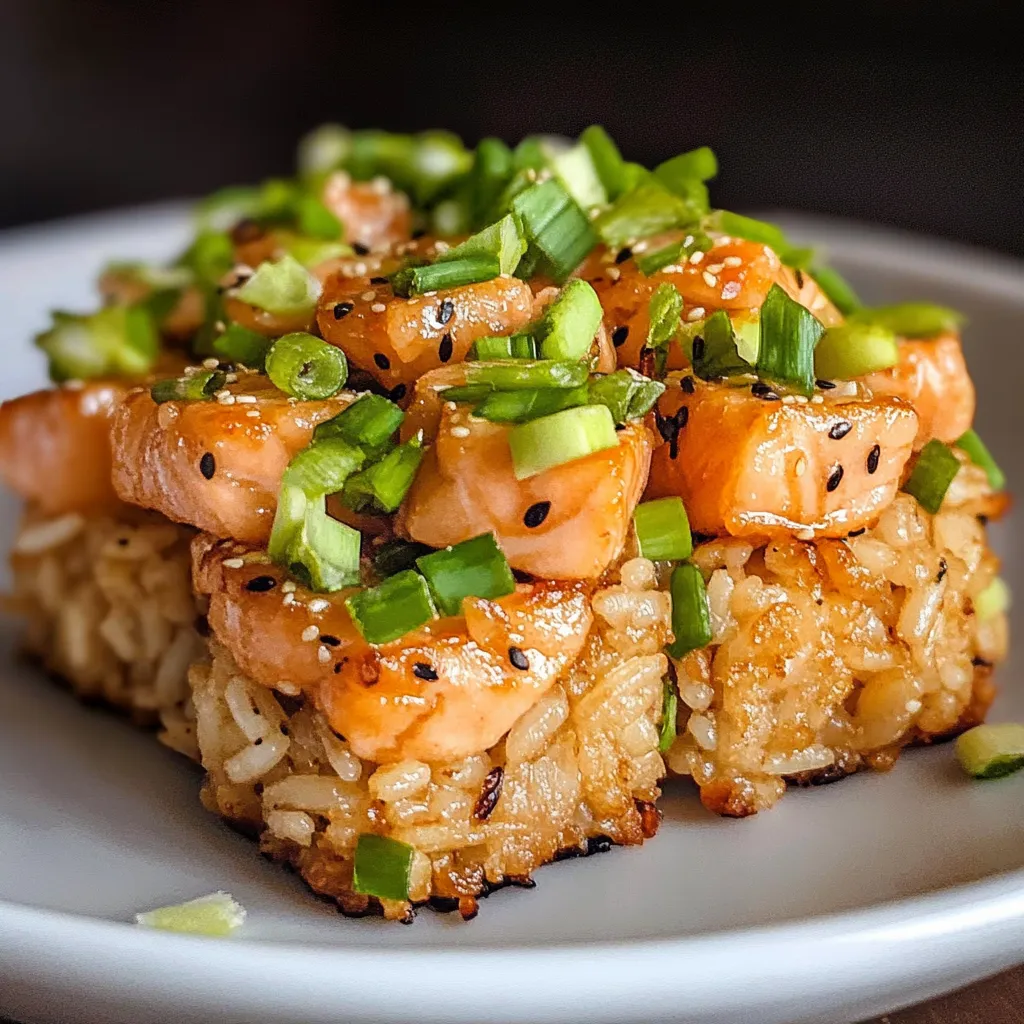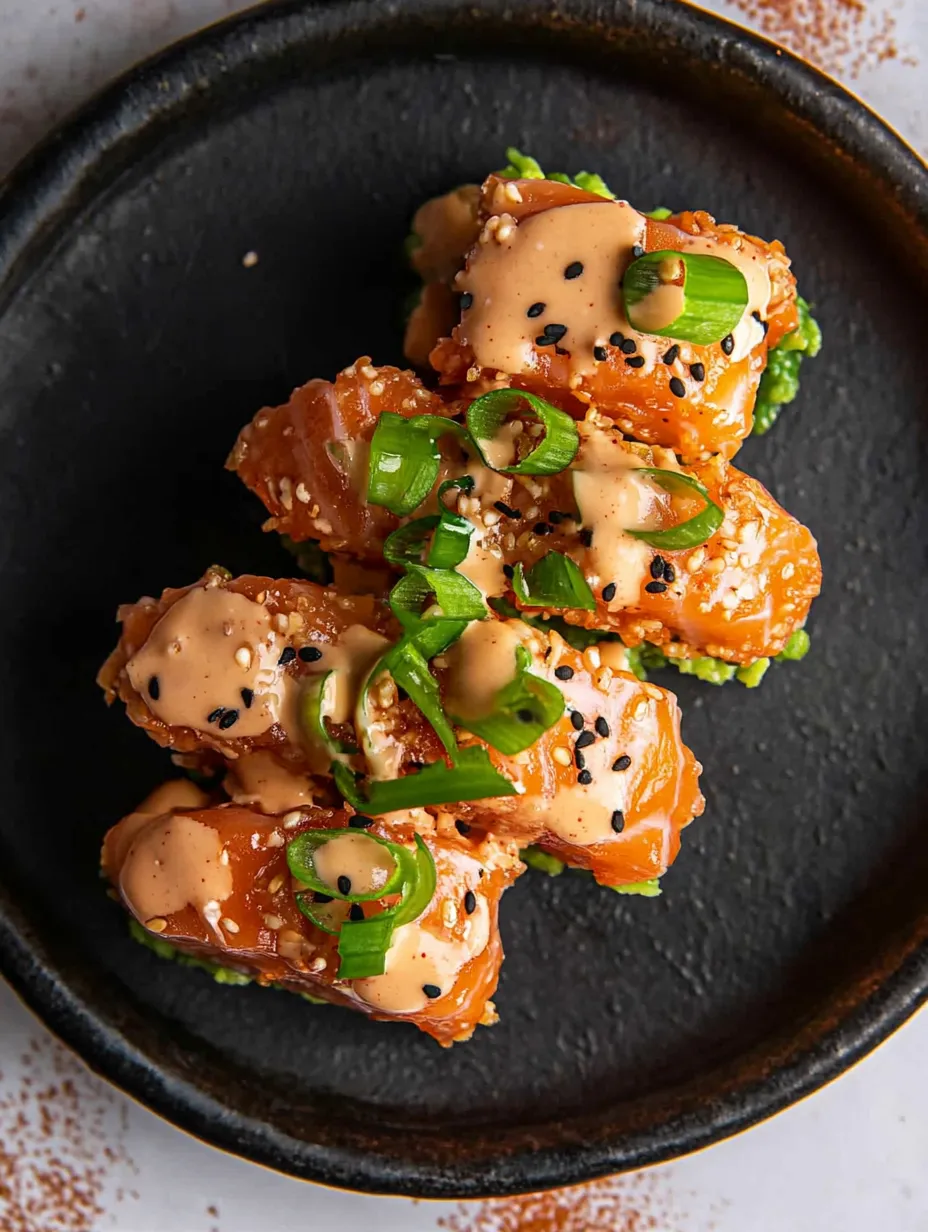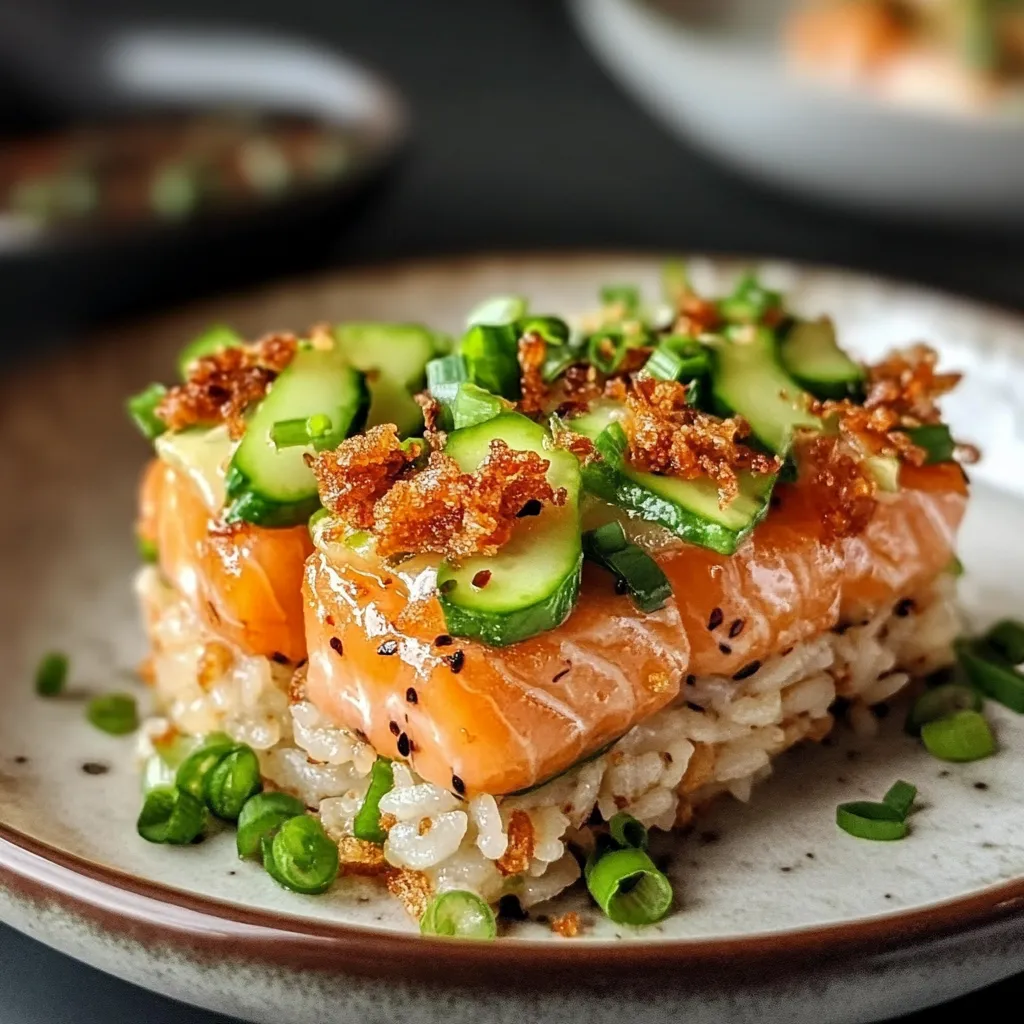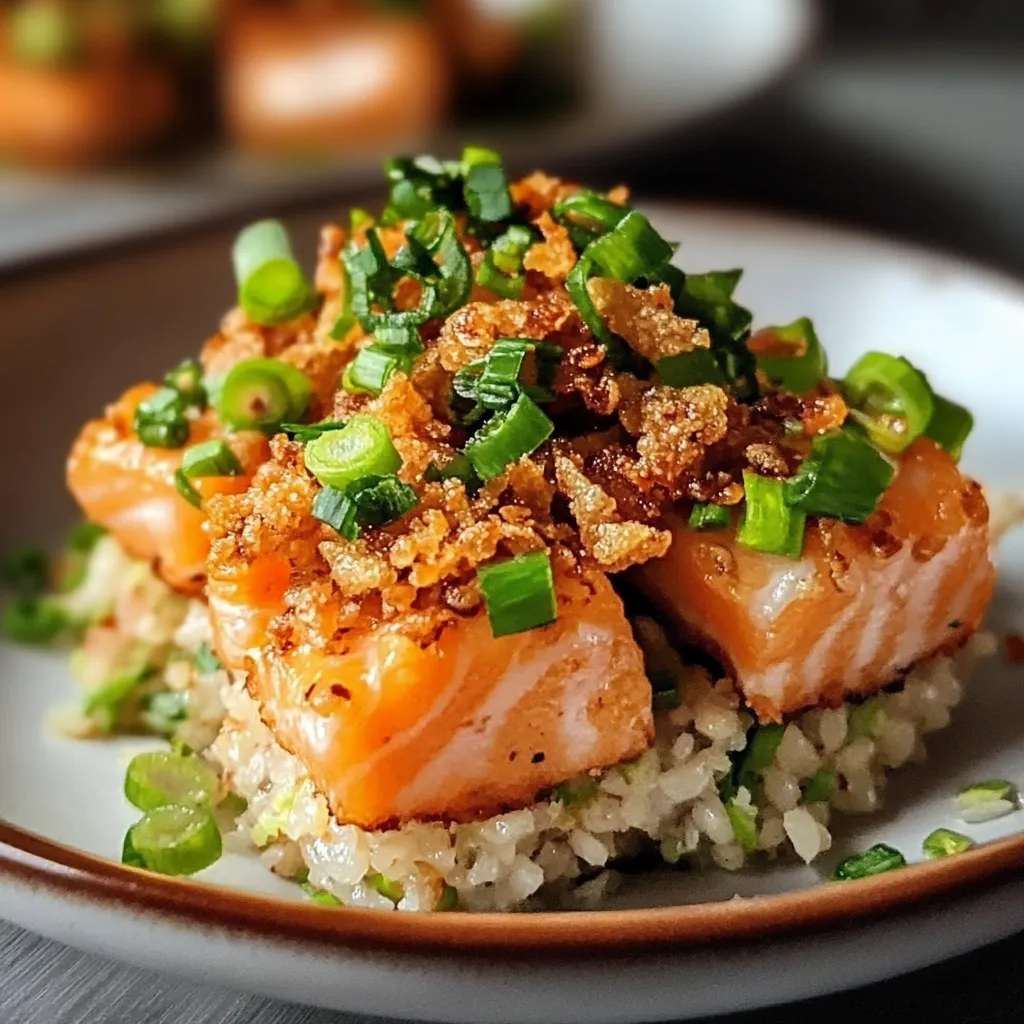 Pin
Pin
The allure of perfectly crispy sushi rice topped with velvety salmon lies in its contrasts - warmth against cool, crispy against creamy. This dish represents modern fusion cuisine at its finest, transforming traditional sushi elements into something entirely new. In my kitchen, it's become a favorite for both casual gatherings and elegant dinner parties, always drawing admiration for its visual appeal and complex flavors.
Last night, I served these at a dinner party, and guests couldn't believe they were homemade. The secret lies in understanding a few key techniques and taking time with each component.
Essential Ingredients and Selection Tips
- Sushi Rice: Use premium short-grain Japanese rice only. The higher starch content is crucial for achieving that perfect crispy exterior while maintaining a chewy center
- Salmon: Fresh sushi-grade salmon is essential. Look for bright color, firm flesh, and no fishy smell. I get mine from a trusted Japanese market where they understand proper handling
- Kewpie Mayo: Its rich egg yolk base and umami notes make it superior to regular mayonnaise. Find it in Asian markets or specialty stores
- Rice Vinegar: Choose authentic Japanese rice vinegar for its subtle, clean flavor. Avoid seasoned vinegars as we'll season the rice ourselves

The foundation of perfect crispy rice lies in proper preparation. Begin by washing your sushi rice thoroughly until the water runs clear - this removes excess starch that could make the rice gummy. Cook according to package directions, then season while hot with your vinegar mixture. The rice needs to cool completely before pressing; patience here is crucial.
Mastering the Rice Base
Line a 9x13 baking pan with plastic wrap, leaving overhang. Press the cooled rice firmly into the pan - I mean really firmly. Use a rice paddle or flat spatula, applying even pressure to create a compact layer about 1/2 inch thick. This compression is vital for achieving that perfect crispy exterior. Cover and refrigerate overnight.
Preparing Perfect Salmon
While the rice chills, focus on your salmon. Dice it into small, uniform pieces - not too fine, you want some texture. The spicy sauce should complement, not overwhelm. Mix Kewpie mayo, sriracha, and soy sauce gradually, tasting as you go. The sauce should be creamy but still let the salmon's flavor shine through.
The Art of Frying
Heat your oil to exactly 350°F - temperature control is everything here. Cut your chilled rice into rectangles and fry in small batches. Watch as they transform from white to golden brown, about 3-4 minutes per side. The sizzle should be gentle, not aggressive.
Assembly Strategy
Work quickly once your rice is fried. Top each crispy base with a thin layer of mashed avocado, then your spicy salmon mixture. The warmth of the rice creates a perfect temperature contrast with the cool toppings.
Chef's Essential Tips

Extended Final Thoughts
This dish represents the evolution of modern Japanese cuisine, where traditional techniques meet contemporary presentation. Through countless iterations, I've learned that success lies in respecting both the traditional elements while embracing innovation. The rice must be perfectly cooked and seasoned, the salmon impeccably fresh, yet the final presentation can be playful and modern.
Personal Reflection
My journey with this recipe began in Tokyo's back-street izakayas, where chefs taught me the importance of rice preparation. Each component carries meaning - the precise cutting of fish, the careful temperature control, the thoughtful assembly. What started as a traditional technique has evolved into something uniquely contemporary while maintaining its soul.
Cultural and Historical Context
Crispy rice sushi represents the natural evolution of Japanese cuisine in the modern world. While traditional sushi prizes simplicity and refined technique, this contemporary interpretation adds textural elements and bold flavors that appeal to global palates. It's a perfect example of how classical cooking techniques can adapt and thrive in new contexts while maintaining their fundamental integrity.
Temperature and Timing Mastery
The success of crispy rice lies in understanding heat management at every stage. Let the rice come to room temperature for 15 minutes before frying - ice-cold rice can lower oil temperature too drastically. When frying, maintain that steady 350°F, adjusting heat as needed.
Creative Variations
While spicy salmon is classic, this technique welcomes other toppings. Try hamachi with yuzu kosho, torch-seared toro with truffle oil, or even vegetarian options like spicy tofu and pickled radish. Each variation teaches something new about balance and presentation.
Plating Artistry
Presentation elevates these bites from good to memorable. Arrange them in odd numbers on long plates, garnish with micro herbs, or create a dramatic line of varying toppings. I often add dots of wasabi aioli or spicy mayo for both flavor and visual appeal.
Textural Symphony
Each component contributes to the perfect bite. The rice base should shatter audibly, giving way to a tender interior. The salmon mixture provides silky richness, while toppings add fresh crunch. This interplay of textures makes each piece an experience.
Scaling for Parties
For larger gatherings, develop a system. Prep rice bases in advance, keeping them warm in a low oven. Create an assembly line with prepared toppings. This allows you to serve pieces that maintain their temperature and textural contrasts throughout service.
Flavor Building

Layer flavors thoughtfully. A touch of yuzu kosho in the spicy mayo, a sprinkle of togarashi on the avocado, or a few drops of aged soy sauce can elevate the entire bite. Think of each piece as a complete flavor journey.
Service Timing
These should be served within minutes of assembly. If needed, prepare components ahead but assemble à la minute. The magic happens when warm, crispy rice meets cool toppings - timing is everything.
Evening Service Elegance
For dinner parties, create a dramatic presentation by serving these bites on dark slate or marble. Arrange edible flowers, micro herbs, and citrus segments around the pieces. Consider serving with chilled sake or champagne for an elevated experience.
Storage Solutions
While best fresh, components can be prepared ahead. Store pressed rice covered tightly in the refrigerator for up to 24 hours. Prepare salmon mixture no more than 4 hours before serving, keeping chilled. Never pre-assemble
Recipe FAQs
- → Can I use regular mayonnaise instead of Kewpie mayo?
- While Kewpie mayo is recommended for its unique flavor, you can substitute with regular mayonnaise if needed.
- → Can I make the crispy rice ahead of time?
- Yes, you can prepare the crispy rice in advance and store it in an airtight container until ready to assemble and serve.
- → Can I use a different type of fish instead of salmon?
- Absolutely! You can experiment with other types of sushi-grade fish like tuna or yellowtail for a different flavor.
- → Can I make these vegetarian or vegan?
- To make these vegetarian or vegan, you can omit the salmon and use a plant-based protein or vegetable topping instead.
- → How should I store any leftovers?
- It's best to enjoy these crispy rice bites fresh, but any leftovers can be stored in the refrigerator for up to 2 days. The rice may lose some crispness, but they'll still be delicious.
